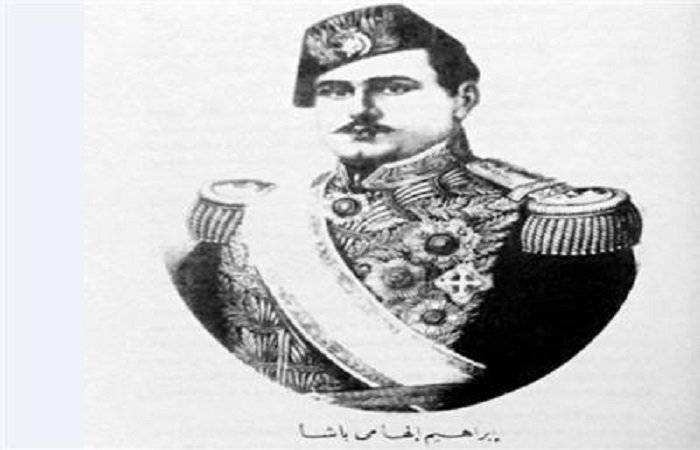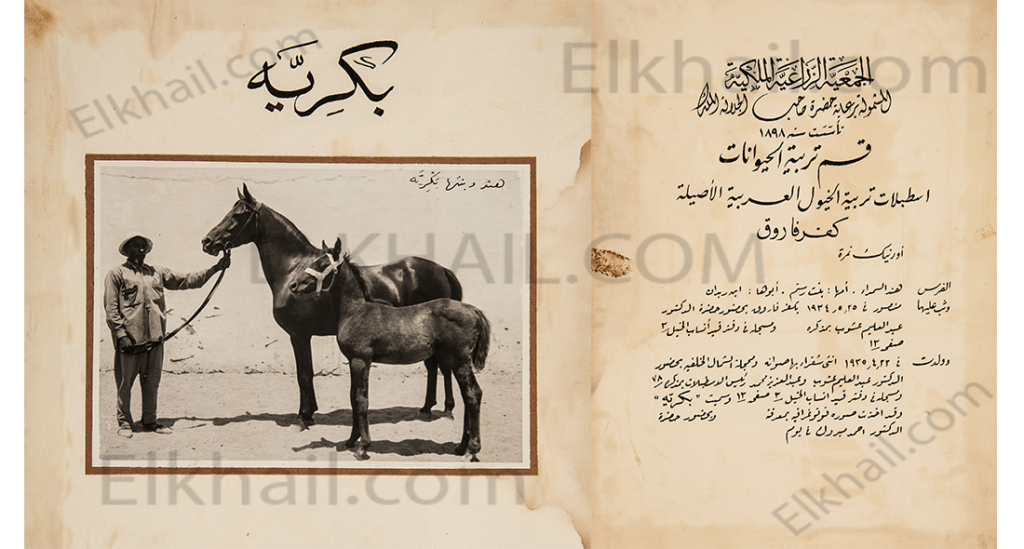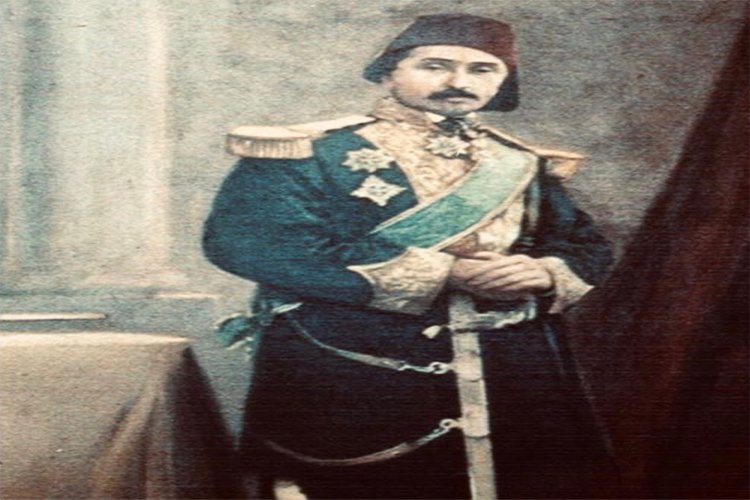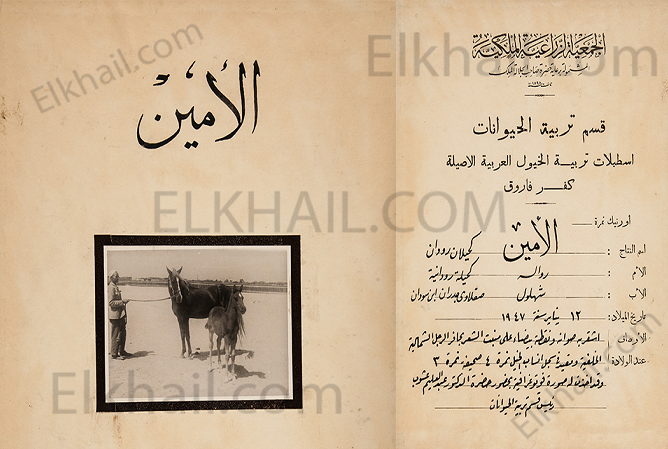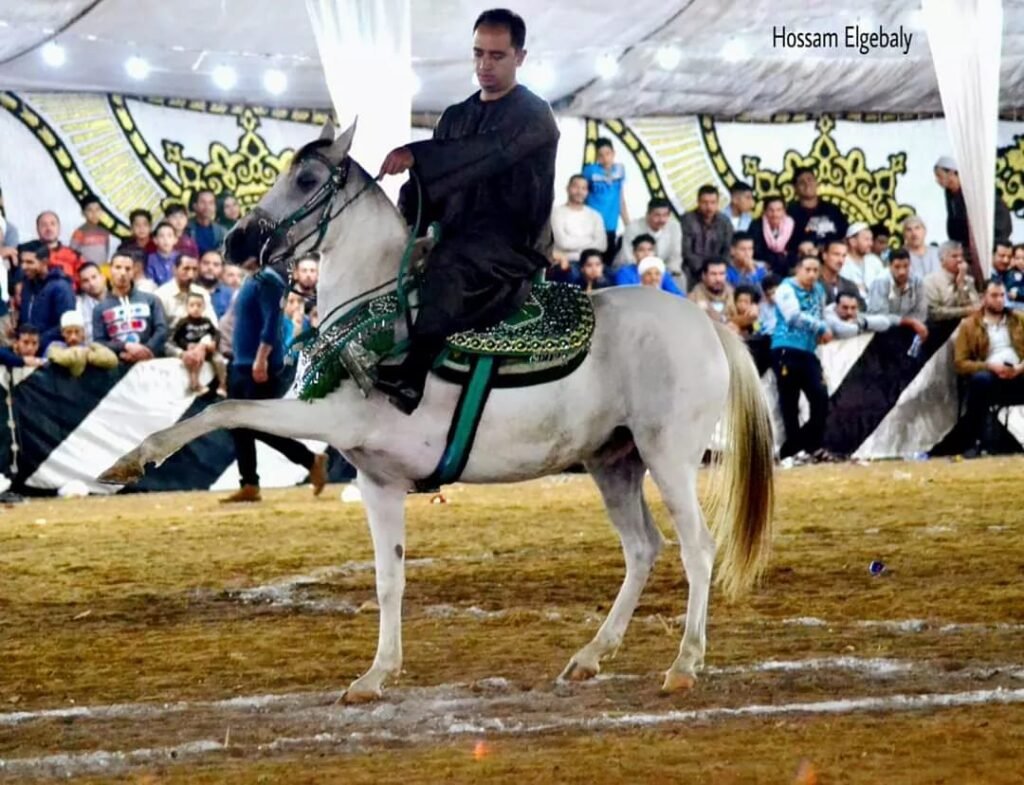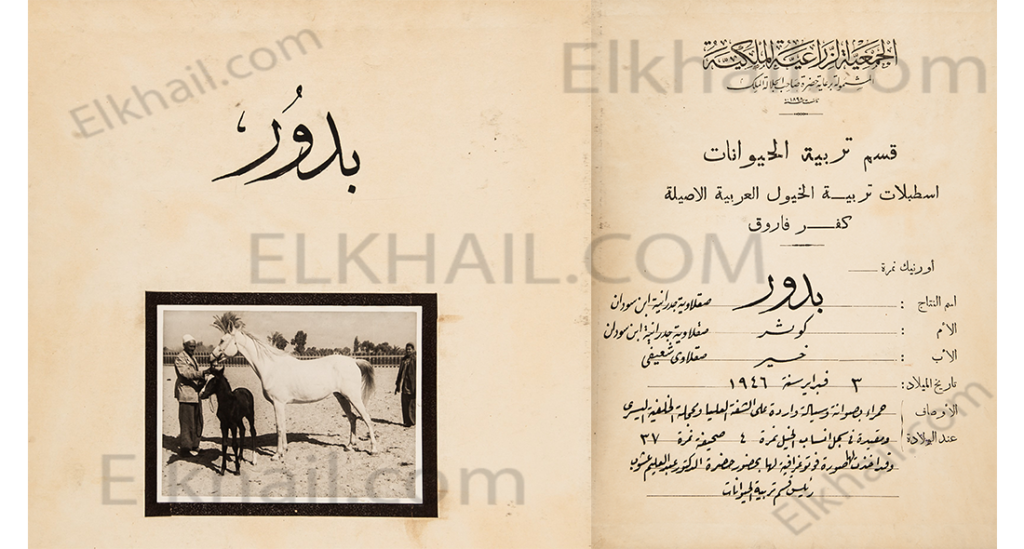Whoever reads history well, and peruses documents and documents, knows that Ilhami Pasha preserved his father’s horses, and that horses multiplied during his reign, and that out of his strong love for horses, he became giving them gifts to those he loved, especially since he had horses that no one else had, represented in the treasure he cared about. His father. Ilhami Pasha held an auction to sell some horses, and they were sold for a great price. Prince Muhammad Ali Tawfiq tells of the auction organized by Ilhami Pasha months before his death in which he sold 240 horses,…
Author: mohamed saleh
The mare Bakriya was born on April 22, 1935, from mother Hind al-Samarra and father Mansour, and was entered in the horse genealogical register, Namera 3, Number 13. The description of the mare, Bakria: “Blonde with a flint and a bollard in the north background.” A photograph was taken of her in the presence of Dr. Ahmed Mabrouk, Head of the Animal Breeding Department at Kafr Farouk Station.
If Abbas Pasha I was the founder of the Egyptian horse kingdom and the collector of its great breeds from everywhere, especially the Arabian Peninsula, then the credit for preserving these breeds goes to Ali Pasha Sharif, for the blood of the Egyptian horse that is presently present in all countries of the world belongs to his horses. Prince Muhammad Ali Tawfiq says about him in his book “About the Pure Horses in Egypt”: Egypt has been fortunate to have a great man who is passionate about horses like Ali Pasha Sharif and constantly undertakes to raise the best of…
The “Ameen” horse, Khilan Rodan, was born on January 12, 1947, from the mother, Rawala, who is Kheila Rodaniya, and the father, Shahloul Saqlawi Jadari, the son of Sudan. Al-Amin described it as “blond with a flint and a white spot on the hairline on the left man’s hoof.” A photograph was taken of him in the presence of Dr. Abdel Alim Ashoub, head of the animal husbandry department at Kafr Farouk station (Al-Zahra station).
Horse literature has gained great popularity in weddings and happy occasions; In the past, there were no rural bands, wedding halls, or DJs, and the municipal drum and flute were the main and essential element in all weddings, and there was a connection and love between the hearts of the Egyptians and their dancing horses, and there became pioneers of horse literature or dancing horses, waiting for the weddings. To see their beautiful lover. As a result, the skills of folk equestrianism and its knights developed, and there became a kind of courtesies at weddings, and there were those who…
The mare “Badur” “Saqlawiya” “Grandyah” Ibn Sudan, was born on February 3, 1946, from the mother Kawthar, who is “Saqlawiya” “Grandyah” Ibn Sudan, and the father “Khair” “Saqlawi” Shaifi, and it is registered in the horse genealogical register, number 4 Number 37 newspaper. Bedour’s descriptions are: “a red with a flange and a flowing spur on the upper lip and the left posterior obturator,” and a photograph was taken of it in the presence of Dr. Abdel-Alim Ashoub, Head of the Animal Husbandry Department at Kafr Farouk Station (Al-Zahraa Station).
The name Al-Tahawiyah is currently associated with the names of the horses: Fella, Fitna and Bint Barakat, and they are the three founding mare of Hamdan stables, whose production spread after that. Any horse you return to is internationally recognized. Ahmed Pasha Hamza was a lover of Al-Asayel, and he took from Al-Tahawiyah three foals from the sons of the horse Barakat bin Al-Dahma Al-Shahwaniyah, and his father Dahman the Great, Sheikh Abdullah bin Saud Al-Tahawi bought it from Sheikh Jadaan bin Mahid Al-Kabeer from the sheikhs of the Anza tribe in Najd. Ahmed Pasha entered the three foals into…
“Horse literature” or “dance” is purely Egyptian folklore, which developed over the ages, until it became the form we see in it now. The horse’s step fascinates non-specialists and specialists in the world of horses as well. The manners of a horse is to tame it to perform several specific coordinated movements, and its perfection lies in its consistency and the horse’s response to it. Horse literature is one of the popular equestrian games, the most famous of which is currently in Egypt, as some of its movements were derived from it, or added to the game of drasaj, and…
Prince Omar Toson succeeded in combining affiliation with the ruling house and closeness to the people and their various sects, broad wealth and hard work, engaging in public work, immersion in study and composition, adherence to the issues of the homeland and a sense of the concerns of the Islamic world. Above all, he possessed high chivalry that rose to the aid of the desperate and the needy of individuals, institutions and nations. He put his money and prestige in the service of his country. Prince Omar Toson is the second son of Prince Tousun bin Muhammad Said bin Muhammad…
Talking about Sultan Hussein Kamel and his relationship to purebred horse breeding is always linked to highlighting his great works that confirmed Egypt’s leading position, and established it in the field of thoroughbred horse breeding, care and care. The credit for the establishment of the Royal Agricultural Society goes to His Highness Prince Hussein Kamel, who assumed the presidency of the Society from the first meeting on March 30, 1898 to December 19, 1914, until he assumed the throne of the Egyptian Sultanate. Prince Hussein Kamal also gave great attention to horses, as horse breeding began in the Agricultural Society…




